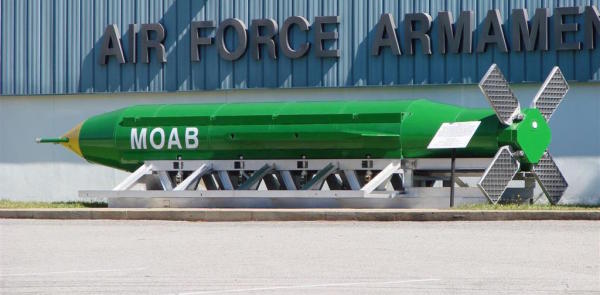

On Thursday, the U.S. Air Force used a GBU-43 Massive Ordnance Air Blast (MOAB) bomb in combat for the first time in history.
The second-largest non-nuclear bomb in the Pentagon’s arsenal, the ordnance was dropped on an ISIS tunnel network and insurgents in the Achin district of the Afghanistan’s Nangarhar province.
“The airstrike was designed to minimize the risk to Afghan and U.S. Forces conducting clearing operations in the area while maximizing the destruction of ISIS-K fighters and facilities,” CENTCOM said in a statement.
First tested in 2003 and unofficially nicknamed the “mother of all bombs,” the GBU-43 is a 21,600-pound, GPS-guided munition that utilizes an airburst detonation that increases its destructive range. It is second in the U.S. military’s arsenal of massive bombs only to the GBU-57A/B Massive Ordnance Penetrator, which weighs in at a whopping 30,000 pounds and can cut through 22 feet of concrete or over 100 feet of earth, according to Wired.
Yes, this is a massive, massive bomb, but you don’t fully get a sense of its power until you see what it looks like in action:
https://www.youtube.com/watch?v=RFTQZ48J3kU
This may be the first deployment of the GBU-43 in U.S. military history, but based on Pentagon statements, it likely won’t be the last. Previously, the bomb was only used in psychological warfare: intimidation.
“As ISIS-K’s losses have mounted, they are using IEDs, bunkers and tunnels to thicken their defense,” Gen. John W. Nicholson, commander of U.S. forces in Afghanistan, said in the statement. “This is the right munition to reduce these obstacles and maintain the momentum of our offensive against ISIS-K.”
President Donald Trump praised the strike as a success.
“We have incredible leaders in the military and we have incredible military and we are very proud of them,” he said. “This was another very, very successful mission.”
